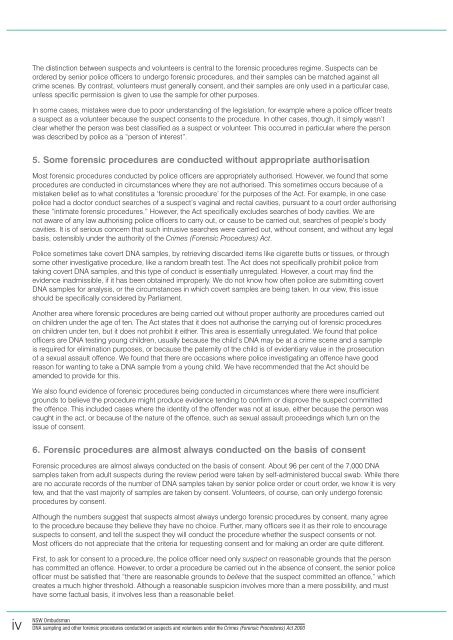Crimes (Forensic Procedures) Act 2000 - NSW Ombudsman - NSW ...
Crimes (Forensic Procedures) Act 2000 - NSW Ombudsman - NSW ...
Crimes (Forensic Procedures) Act 2000 - NSW Ombudsman - NSW ...
Create successful ePaper yourself
Turn your PDF publications into a flip-book with our unique Google optimized e-Paper software.
The distinction between suspects and volunteers is central to the forensic procedures regime. Suspects can be<br />
ordered by senior police officers to undergo forensic procedures, and their samples can be matched against all<br />
crime scenes. By contrast, volunteers must generally consent, and their samples are only used in a particular case,<br />
unless specific permission is given to use the sample for other purposes.<br />
In some cases, mistakes were due to poor understanding of the legislation, for example where a police officer treats<br />
a suspect as a volunteer because the suspect consents to the procedure. In other cases, though, it simply wasn’t<br />
clear whether the person was best classified as a suspect or volunteer. This occurred in particular where the person<br />
was described by police as a “person of interest”.<br />
5. Some forensic procedures are conducted without appropriate authorisation<br />
Most forensic procedures conducted by police officers are appropriately authorised. However, we found that some<br />
procedures are conducted in circumstances where they are not authorised. This sometimes occurs because of a<br />
mistaken belief as to what constitutes a ‘forensic procedure’ for the purposes of the <strong>Act</strong>. For example, in one case<br />
police had a doctor conduct searches of a suspect’s vaginal and rectal cavities, pursuant to a court order authorising<br />
these “intimate forensic procedures.” However, the <strong>Act</strong> specifically excludes searches of body cavities. We are<br />
not aware of any law authorising police officers to carry out, or cause to be carried out, searches of people’s body<br />
cavities. It is of serious concern that such intrusive searches were carried out, without consent, and without any legal<br />
basis, ostensibly under the authority of the <strong>Crimes</strong> (<strong>Forensic</strong> <strong>Procedures</strong>) <strong>Act</strong>.<br />
Police sometimes take covert DNA samples, by retrieving discarded items like cigarette butts or tissues, or through<br />
some other investigative procedure, like a random breath test. The <strong>Act</strong> does not specifically prohibit police from<br />
taking covert DNA samples, and this type of conduct is essentially unregulated. However, a court may find the<br />
evidence inadmissible, if it has been obtained improperly. We do not know how often police are submitting covert<br />
DNA samples for analysis, or the circumstances in which covert samples are being taken. In our view, this issue<br />
should be specifically considered by Parliament.<br />
Another area where forensic procedures are being carried out without proper authority are procedures carried out<br />
on children under the age of ten. The <strong>Act</strong> states that it does not authorise the carrying out of forensic procedures<br />
on children under ten, but it does not prohibit it either. This area is essentially unregulated. We found that police<br />
officers are DNA testing young children, usually because the child’s DNA may be at a crime scene and a sample<br />
is required for elimination purposes, or because the paternity of the child is of evidentiary value in the prosecution<br />
of a sexual assault offence. We found that there are occasions where police investigating an offence have good<br />
reason for wanting to take a DNA sample from a young child. We have recommended that the <strong>Act</strong> should be<br />
amended to provide for this.<br />
We also found evidence of forensic procedures being conducted in circumstances where there were insufficient<br />
grounds to believe the procedure might produce evidence tending to confirm or disprove the suspect committed<br />
the offence. This included cases where the identity of the offender was not at issue, either because the person was<br />
caught in the act, or because of the nature of the offence, such as sexual assault proceedings which turn on the<br />
issue of consent.<br />
6. <strong>Forensic</strong> procedures are almost always conducted on the basis of consent<br />
<strong>Forensic</strong> procedures are almost always conducted on the basis of consent. About 96 per cent of the 7,000 DNA<br />
samples taken from adult suspects during the review period were taken by self-administered buccal swab. While there<br />
are no accurate records of the number of DNA samples taken by senior police order or court order, we know it is very<br />
few, and that the vast majority of samples are taken by consent. Volunteers, of course, can only undergo forensic<br />
procedures by consent.<br />
Although the numbers suggest that suspects almost always undergo forensic procedures by consent, many agree<br />
to the procedure because they believe they have no choice. Further, many officers see it as their role to encourage<br />
suspects to consent, and tell the suspect they will conduct the procedure whether the suspect consents or not.<br />
Most officers do not appreciate that the criteria for requesting consent and for making an order are quite different.<br />
First, to ask for consent to a procedure, the police officer need only suspect on reasonable grounds that the person<br />
has committed an offence. However, to order a procedure be carried out in the absence of consent, the senior police<br />
officer must be satisfied that “there are reasonable grounds to believe that the suspect committed an offence,” which<br />
creates a much higher threshold. Although a reasonable suspicion involves more than a mere possibility, and must<br />
have some factual basis, it involves less than a reasonable belief.<br />
iv<br />
<strong>NSW</strong> <strong>Ombudsman</strong><br />
DNA sampling and other forensic procedures conducted on suspects and volunteers under the <strong>Crimes</strong> (<strong>Forensic</strong> <strong>Procedures</strong>) <strong>Act</strong> <strong>2000</strong>

















